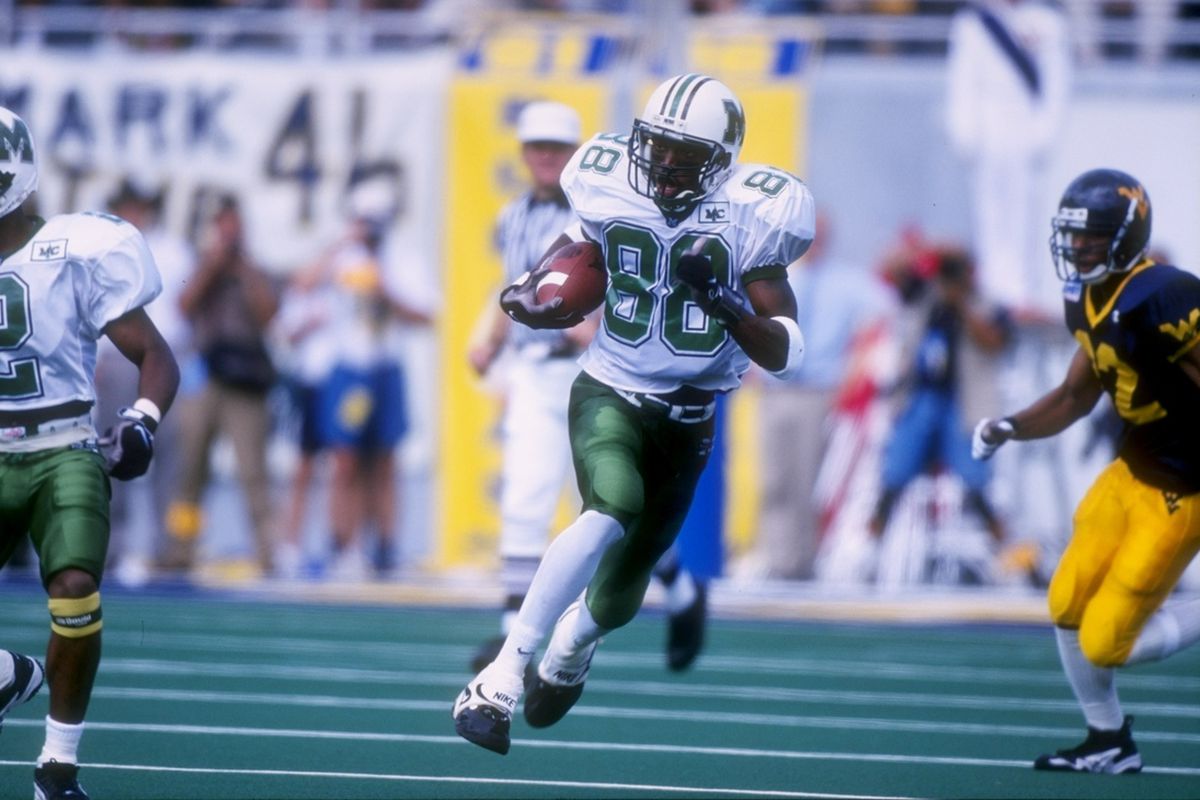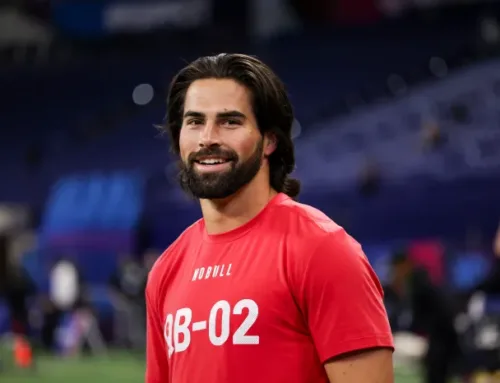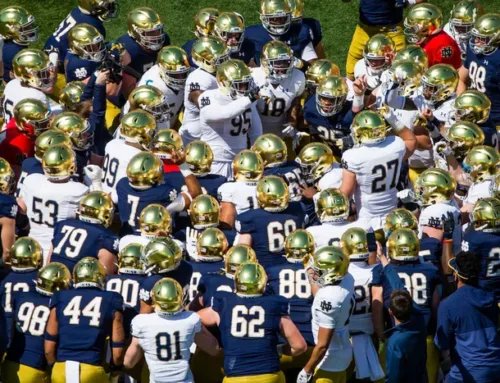Rand, West Virginia sits on a tiny strip of land on the eastern banks of the Kanawha River about a 10-minute drive south of the state capital in Charleston. If you’ve watched the 2015 documentary Rand University you know how much of a profound affect Randy Moss’ hometown has on his life. It would be that complicated relationship in rural West Virginia that would ultimately prevent Moss from attending the University of Notre Dame.
Or maybe that was only part of the reason.
First, let’s go back to the 1994-95 school year. As a senior at DuPont High School, Moss was one of the most decorated prep athletes in state, and frankly national, history. Many thought he was the best West Virginia athlete since Jerry West. He totaled 44 touchdown receptions while playing receiver in addition to duties at safety while kicking, punting, and being a return man. In basketball, he averaged an absurd 30.2 points and 13.7 rebounds as West Virginia Player of the Year in both hoops and football. Although he didn’t run as an upperclassman, Moss was the state champion in the 100 meter and 200 meter races as a sophomore.
Numerous legendary coaches, including Lou Holtz, remarked that Moss was the greatest high school football player they had ever seen. No one in football history was as tall (6’5″) and fast as Moss.
Notre Dame football in 1994 was reeling hard. The Irish fell from grace finishing a shocking 6-5-1 and were feeling the effects of a mediocre period of recruiting since the late 80’s glory days. However, that was all set to change for the upcoming 1995 cycle as Notre Dame inked the consensus No. 1 class in the country, and according to insider Tom Lemming, it was one of the best classes he’d seen to that point of his career.
Moss had Notre Dame, Tennessee, and Florida among his finalists but his heart was set long before 1995 came around. From the LA Times:
Moss had one recurring football dream: playing for Notre Dame. He and his brother used to fight over who loved the Irish more.
“Usually we’d start naming players, All-Americans, Heismans, numbers, ‘Back in this day who wore number so and so,’ ” Moss says, explaining the competition. “It was like a trivia game, really. Who likes them the most.”
Moss was in heaven the day Notre Dame sent him a questionnaire. There would be no recruiting war. Moss was going to South Bend.
Following a late in-home visit from Holtz in the spring, Moss would eventually give his verbal to the blue and gold a couple days after National Signing Day in February 1995. It was the cherry on top of Notre Dame’s comeback recruiting sundae as the program looked to firmly re-load for the remainder of the decade and make sure 1994 was just a tiny blip.
Two problems popped up, though. Moss would be soon in trouble with the law and he was also yet to officially gain admission to the University of Notre Dame.
On March 24, 1995 a fight broke out at school between a friend of Moss’ (who was black) and another student who carved the N-word on a desk. It was a one-sided fight with Moss’ friend throwing the other boy to the ground and kicking him repeatedly. Moss finished things off with two more kicks and the student ended up in the hospital with a torn spleen.
Moss’ friend was still a minor and not charged. Moss had recently turned 18 and was facing a felony for malicious wounding. The football star was kicked out of DuPont High School and had to finish his degree at Cabell Alternative School in Charleston.
There’s an alternate history where Moss might have overcome these legal troubles and still enrolled at Notre Dame. Most stories on the subject today claim the Irish dropped Moss strictly due to the fight and that’s certainly how the player felt at the time:
“I think that Notre Dame really let me go just because of the fight. That was the main reason. Notre Dame is a Catholic school. You come to a Catholic School, they want you on best behavior. If I’d went there, I’d have been, you know, going to court, prosecuted, things like that. There would have been some negative publicity at Notre Dame and I don’t think they wanted something like that.”
However, compounding the issue was the status of Moss’ application to the university. Some claim it came 3 months late after National Signing Day while others claim as many as 5 different attempts were sent to the school by late spring. Either way, Notre Dame has stated that the application was never fully completed, didn’t show an honest attempt to fill it out earnestly, and was missing a fully completed essay.
On June 23, 1995 Lou Holtz had caved to the internal school pressure and announced that Randy Moss was denied admission to Notre Dame. The director of undergraduate admissions Kevin Rooney at the time expressed to the Chicago Tribune:
“We had four staff members and myself evaluate and discuss the application. We came to a unanimous decision that the totality of the application indicated it was not going to be a good match with Notre Dame.”
Randy Moss’ high school teammate Bobbie Howard gave a verbal to the Irish back on December 27, 1994 but they would never play together in South Bend. Howard would later develop into a quality linebacker and captain as a senior in 1998.
On August 2nd, Moss would plead guilty to a reduced misdemeanor sentence and 30 days in jail. That same day, he announced he would attend Florida State at the blessing of Lou Holtz who released Moss from his Letter of Intent. As a technical transfer, Moss had to sit out the 1995 season. Nine months later, Moss was kicked out of Florida State after violating his probation following an admission he smoked marijuana while on a work-release program back home in West Virginia.
The rest of the story is more familiar to football fans–Moss would wind up at Marshall University an hour west of his hometown for the 1996 season. In two years (the first in I-AA and the second in the MAC) Moss finished with 3,467 receiving yards and 54 receiving touchdowns and placed 4th in the 1997 Heisman race.
Remarkably, as he dealt with the small-school bias and off-the-field flags, Moss wouldn’t come off the board in the 1998 NFL Draft until the 21st pick as the second receiver behind Utah’s Kevin Dyson. However, Moss won AP Rookie of the Year and would finish with a whopping 12,967 more receiving yards than Dyson on his way to a Hall of Fame career.
***
One of the most common message board and bar room discussions for a quarter century is how much Randy Moss would’ve saved Notre Dame if he was able to follow through on his dream and play for Lou Holtz. Would it really have worked out?
Certainly, the 1995 season could’ve been something special. The Irish had a very strong run game with Randy Kinder, Marc Edwards, and Autry Denson in the backfield plus Moss could’ve teamed up with senior Derrick Mayes at receiver. The offense finished 15th nationally in scoring without Moss and you’d think 2 out of the 3 losses (opener against Northwestern and bowl game versus Florida State, the latter without an injured Ron Powlus) would’ve been reversed.
The 1996 offense was similarly explosive and it’s not hard to imagine Notre Dame winning all their games for 1995-96 outside of the Ohio State matchups. And you could maybe convince yourself the Irish would take the home matchup against the Buckeyes in ’96 to be a true National Championship contender.
However, it seems like many obstacles could’ve been faced for Moss at Notre Dame.
Although we can look back at the justice system treatment for Moss with much more skeptical eyes 25 years later, it was clear he had some maturity issues that likely manifested into some academic trouble as a freshman. It’s also very possible his idyllic construct of Notre Dame confronted a harsh reality once he made it to campus and was faced with the regular day-to-day rigors of student-athlete life in South Bend.
Obviously, Notre Dame was far from a pass-happy program in the mid-1990’s so it would’ve been a much different set up than what Moss experienced at Marshall. For example, the Thundering Herd threw for 4,025 yards in Moss’ final collegiate season. Ron Powlus threw for 5,873 yards over the 3 seasons from 1995-97.
It’s hard not to think Moss completely rejuvenates the program and Lou Holtz sticks around for many more years. It’s also possible he hated being at Notre Dame and catching 750 yards a season even on a good team was a recipe for discontentment and a transfer. If Holtz had still retired after 1996 it would’ve been interesting to see Moss in year one under Davie, too. That offense cratered to just 21.7 points per game and struggled mightily in the first post-Powlus season.
It’ll always be fun to imagine Moss wearing the gold helmet, though. It would’ve been awesome if his dream of playing for Notre Dame became a reality. It’s one of the school’s greatest modern “what if” moments.





Yess, glad you put this together. I do agree with the conclusions at the end that Moss as a young man was probably wouldn’t have worked out at Notre Dame (as he kinda reflected on at Rand University that he had a long journey to go through), but man, it would have been so electric. When even Bobby Bowden couldn’t finesse the system keep him in a major program in the mid ’90s that says a lot considering what he was capable of (like Peter Warrick incident). I also always thought of it as a really nice gesture by Holtz to pass Moss off to a guy in Bowden who was known as the guy to help troubled youngsters out in that era.
Maybe the black hole of the 2000’s was bound to happen no matter what, but it’s fun to live in a timeline where Randy Moss makes/keeps Notre Dame cool to the younger generation and helps give some individuals a boost to the prestige of the program. Coulda been great and those Marshall highlights are just absurd.
Great article E and great post Hooks. I agree that it would have been great to land such a talented player at ND, but it does not seem like things would have worked out. As noted, the offense was run-heavy at the time, the academics were (and are) rigorous, and we know that the disciplinary arm of the university would not have looked kindly on the criminal case and pot smoking.
The third play in the video is in the running for the greatest touchdown by a receiver. Scary athleticism at his height!
I just watched that — wow!!!
I had totally forgotten about Pennington. The NFL probably would have completely ignored him if it had not been for Moss
I don’t think that’s true. Pennington played two seasons at Marshall after Moss left, including an unbeaten season.
Wasn’t there a top tier RB denied admission that year also? Was it James Jackson ?
Yup, he eventually landed at Miami and rushed for 2,950 yards and 34 overall touchdowns before becoming a 3rd round pick by the Browns.
The ’95 class was supposed to be Denson and Jackson together.
Javon Kearse almost signed with ND in 1995, too.
As TimsSon pointed out, Allen Iverson was in a Randy Moss-type situation of dreaming about going to Notre Dame as a kid but had legal issues that prevented it. (That seems a little more pie in the sky since Moss actually gave a verbal commitment).
Not sure if Iverson had the frame to make it as a quarterback, but he was really, really electric as a HS football player. I know many back home in Virginia consider Iverson the best prep player they ever saw in the Tidewater area, which is a very strong compliment.
https://www.sportingnews.com/us/other-sports/news/allen-iverson-planned-on-playing-football-at-notre-dame-after-high-school/1vn0x8oxow9ff19axjdu5l75gk
Hopefully, when they were recruiting Iverson, they were recruiting him for dual sports and not just football.
Maybe he could’ve been a slot receiver or nickel corner. Tough to see him playing any other position at a generous 160 pounds in college. Plus, he hated lifting and never would’ve made it through a real S&C program.
“That sh*t was too heavy” he famously said about not lifting in the NBA.
3* corner from California Chance Tucker commits to Notre Dame, seems like Mickens is doing work.
And Blake Fisher (love this kid already) tweeted that “we got another one coming”…Maybe finally a little thaw in the recruiting winter..
Nicely balanced treatment. Maturity at that age is a moving target, it’s hard to say, but the FSU denoument is an indicator.
That third play is indeed astounding